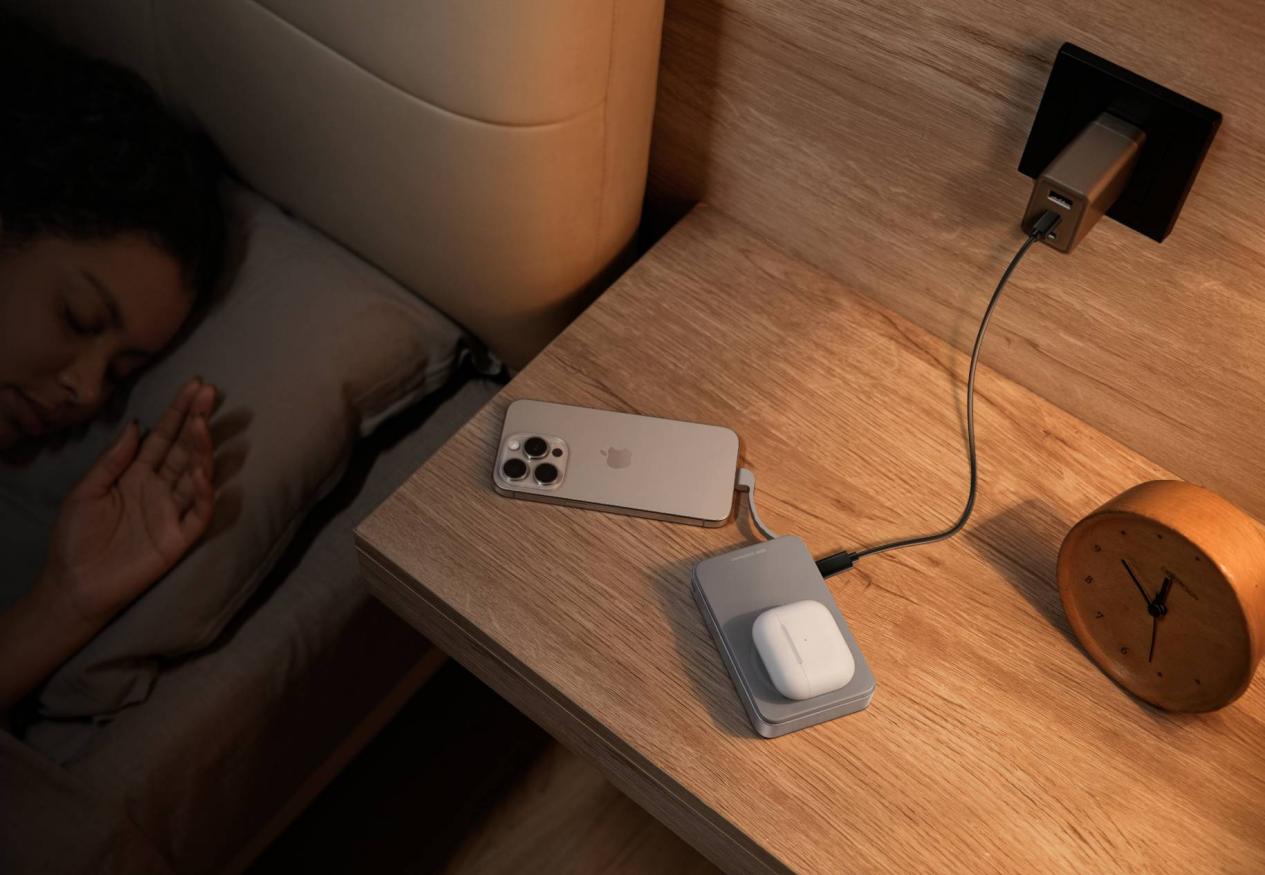Qi vs. MagSafe Charging
- What Is Qi Charging?
- What Is MagSafe Charging?
- Key Differences of Qi and MagSafe Charging
- Which One Should You Choose?
- EcoFlow RAPID Pro Power Bank
- How to Maximize the Lifespan of Your Wireless Charging Devices
- The Future of Wireless Charging
- Choose the Right Charging Technology for Your Needs
- 3 FAQs About MagSafe Charging and EcoFlow RAPID Power Bank
Wireless charging is the fashion nowadays in mobile phones, and it is handy and convenient. Two of the most common methods nowadays for wireless charging are Qi and MagSafe. They are two cousins who look similar because they offer consumers the cable-free method of mobile phone charging, but they are not the same, hence making them unique. Let us compare the two and explore their advantages, helping you choose the most suitable one for you.
What Is Qi Charging?
Qi is the universal open wireless-charging standard. Qi is implemented and utilized across many different devices, including smartphones and gadgets. If you've ever used wireless charging to your phone, there's a good chance you've utilized Qi technology.
How Qi Works
Qi uses electromagnetic induction to transfer energy from the charging pad to the device’s battery. This process starts automatically as soon as the device is placed on the charger.
Key Features
- Wide Compatibility: Qi works with a broad range of devices, including phones from both Android and Apple.
- Affordable Charging Solutions: Qi charging pads come in a variety of price ranges, making it accessible for all budgets.
- Efficiency: While Qi supports up to 15W of power delivery, the speed may differ depending on the device.


What Is MagSafe Charging?
MagSafe is Apple’s proprietary wireless charging system, designed to offer more reliable and faster charging specifically for Apple devices. If you’re a fan of the Apple ecosystem, this charging solution could be a perfect fit for your needs.
How MagSafe Works
MagSafe uses magnetic alignment to ensure that your device is perfectly positioned on the charger. This alignment ensures more efficient charging and eliminates the frustration of misalignment.
- Magnetic Alignment: The magnetic feature automatically guides your device into the optimal charging position.
- Faster Charging: Thanks to the more stable connection, MagSafe offers up to 15W of power delivery, providing faster charging speeds on compatible Apple devices.
- Optimized for Apple Devices: It’s tailored specifically for Apple devices such as iPhones, AirPods, and Apple Watches.
Key Differences of Qi and MagSafe Charging
While both Qi and MagSafe technologies provide wireless charging, they cater to different needs. Understanding their differences helps you make an informed decision based on your preferences and device compatibility.
Feature | Qi Charging | MagSafe Charging |
Charging Speed | Up to 15W (varies by device) | Up to 15W (more stable alignment) |
Compatibility | Works with a wide variety of devices | Exclusively works with Apple devices |
Magnetic Alignment | No magnetic feature, manual placement | Magnetic alignment ensures perfect positioning |
Price Range | Wide range, from budget to premium | Higher price, especially for accessories |
Device Support | Supports many phones, including older iPhones | Only works with iPhone 12 and newer |
Which One Should You Choose?
Choosing between Qi and MagSafe depends on your preferences, your device, and how you prioritize charging speed and ease of use. Here are a few considerations to guide your choice.
Choose Qi Charging If
- You use devices from multiple brands or prefer a more budget-friendly option.
- You don’t need magnetic alignment and are okay with slightly slower charging speeds in some cases.
Choose MagSafe Charging If
- You are fully integrated into the Apple ecosystem and prefer faster, more reliable charging.
- You value the magnetic alignment feature for easier device placement and are willing to invest in accessories designed for Apple devices.
EcoFlow RAPID Pro Power Bank
If you're looking for the ultimate high-capacity portable charging solution, the EcoFlow RAPID Pro 27650 mAh Power Bank could be the perfect choice for power users and professionals.
Key Features:
Massive 27,650mAh Capacity: Air-travel-friendly 99.54Wh capacity provides extended power for laptops, phones, and multiple devices during long trips or work sessions.
300W Multi-Device Charging: Industry-leading total output supports simultaneous charging of up to 4 devices, including high-power laptops and tablets.
140W Built-In Cable: Integrated 60cm retractable USB-C cable eliminates the need for extra cables, providing ultra-fast charging for devices like MacBook Pro and gaming laptops.
Ultra-Fast Recharging: Recharge from 0% to 80% in just 20 minutes using the EcoFlow RAPID Pro 320W Charging Station - one of the fastest speeds available.
Smart LCD Display: Real-time power monitoring with customizable standby graphics to match your style and preferences.
Modular Design: Detachable magnetic cases allow personalization and style matching for a premium, customized look.
App-Connected Intelligence: EcoFlow app integration provides battery optimization modes and smart charging strategies to extend device lifespan.
This power bank is ideal for professionals, content creators, and anyone who needs to charge multiple high-power devices simultaneously. Users can benefit from laptop-grade charging speeds, extended runtime, and the convenience of never needing to carry extra cables.
How to Maximize the Lifespan of Your Wireless Charging Devices
Wireless chargers are a handy accessory these days, but like any other gadget, they require good care so they stay with us for more years. Below is how you maintain your devices in top-notch condition for the coming years.
Proper Alignment: Always ensure that your phone or device is properly aligned on the charging pad to prevent inefficient charging or overheating.
Use Compatible Accessories: Stick to using wireless chargers and accessories that meet safety standards to avoid damaging your device.
Regular Cleaning: Dust and debris can interfere with charging efficiency and cause overheating.
Clean your charging pad regularly to maintain the best performance.
The Future of Wireless Charging
Wireless charging is developing quickly. Its future advancements promise to make it even more convenient and faster.
Faster Charging Speeds: Both Qi and MagSafe technologies are likely to evolve to offer faster charging, potentially reaching speeds of 30W or more.
Longer Range Charging: Researchers are working on enabling wireless charging over longer distances, making it more flexible and convenient for users.
Integration with Smart Homes: Wireless charging might become more integrated into smart home ecosystems, allowing devices like your phone, headphones, or even electric vehicles to charge seamlessly in your home, this is quite different from a mobile power bank.
Choose the Right Charging Technology for Your Needs
Qi and MagSafe are two fantastic wireless charging experiences, and the decision between the two will come down to compatibility and the requirements for your device and charger. In the case that you are fully invested in the Apple ecosystem, the MagSafe is most likely to offer you the most integrated experience with faster and more stable charges. With devices across a number of brands and excellent compatibility at a lower price, the Qi is a great option.
However, if you need maximum power and versatility beyond wireless charging, consider upgrading to a high-capacity solution like the EcoFlow RAPID Pro Power Bank


3 FAQs About MagSafe Charging and EcoFlow RAPID Power Bank
Q1: How do I know if my device supports MagSafe charging?
A: MagSafe is compatible with iPhone 12 and newer models, as well as certain MagSafe accessories like the AirPods case and Apple Watch magnetic accessories. You can check for a magnetic alignment ring on the back of your device to confirm if it supports MagSafe. If your device doesn’t have this magnetic feature, it doesn’t support MagSafe and can only use traditional Qi wireless charging.
Q2: Is the EcoFlow RAPID Pro Power Bank portable for travel?
A: In fact, the EcoFlow RAPID Power Bank is lightweight and small, and thus the ultimate for carrying while traveling. The unit is simple to store in a backpack or suitcase since it is small enough. The internal 65W fast charger cable charges phones and laptops, and thus you never run short of battery while in the field. It charges more devices simultaneously further, and this is a plus while traveling.
Q3: Do I need to buy a special case for MagSafe charging?
A: As the iPhone 12 and subsequent iPhones are all MagSafe-compatible, including a case that is MagSafe-compatible significantly boosts the steadiness and efficiency of a charge. They come with magnets that ensure the proper alignment between the charger and phone for the benefit of faster and more stable charges. Without the utilization of a MagSafe-compatible case, the phone charges, though the magnet connection is not as secure and could lead to slow speeds or instability during charging.